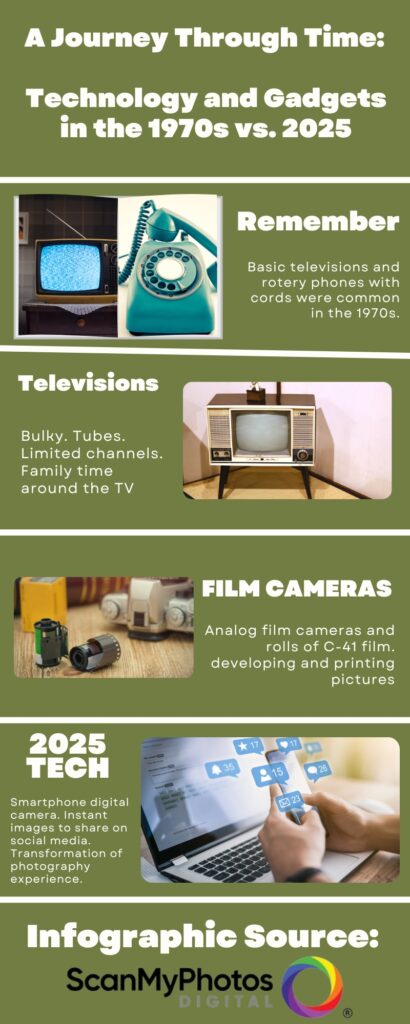A Journey Through Time: Technology and Gadgets in the 1970s vs. 2025
Technology has come a long way since the 1970s, and in this article, we’ll take a trip down memory lane to compare and contrast the gadgets and technological advancements from that era to what we have in 2025. Let’s explore how things have changed, from basic telephones to smartphones and film cameras to instant photo sharing.
Tech in the 1970s:
Telephones: In the 1970s, telephones were typically rotary dial phones with cords attached to the wall. Making long-distance calls was expensive, and you had to remember phone numbers or use a phone book. TVs: Television sets were large, bulky cathode ray tube (CRT) monitors with limited channels. Families gathered around the TV for their favorite shows and news broadcasts.
Computers: In the 1970s, computers were massive mainframes found mainly in large organizations and institutions. They were slow and used punch cards for programming.
Cameras: Photography involved film cameras, which required careful framing as there was no immediate preview. You had to wait for the film to be developed to see the pictures.
Tech in 2025:
Smartphones: Today, smartphones have revolutionized communication. They are powerful pocket-sized devices that allow us to make calls, send messages, browse the internet, and use countless applications for various tasks. TVs: High-definition flat-screen TVs have replaced bulky CRT monitors. Viewers can now access extensive entertainment with cable, satellite, and streaming services. Computers: Modern computers have become faster, smaller, and more efficient. Laptops, tablets, and even powerful smartphones have made computing accessible to everyone.
Cameras: Digital cameras and smartphones have transformed photography. With instant previews and easy sharing options, capturing and preserving memories has never been more convenient.
How Things Changed:
Communication: Communication has evolved from using basic telephones with cords to having smartphones like mini-computers, enabling us to stay connected anytime, anywhere. Information Access: In the 1970s, finding information meant visiting libraries or consulting encyclopedias. Today, the internet has become an endless source of knowledge.
Entertainment: Watching TV shows and movies was limited to scheduled broadcasts in the past, but now we have on-demand streaming services that provide instant access to an array of content.
Computing Power: Computers have gone from giant machines housed in data centers to compact devices we can carry around, and they have become an essential part of our daily lives.
<< Digitize My Pictures Now! >>
Photography: The shift from film cameras to digital ones has transformed how we capture and share photo memories. Instant previews and easy sharing on social media have revolutionized photography.
Over the past 50 years, human ingenuity and creativity have drastically altered the landscape of modern technology. Through communication, entertainment, computing, and photography, the advances in each sector have improved our daily lives in terms of connection and convenience. Smartphones, high-definition TVs, portable computers, and digital cameras are only a few examples of the progress made in this time. Looking forward, one can only anticipate what wonders the future will bring.
As technologists, we have attended CES in Las Vegas each January since 1990 to explore the next-generation gadgets and tech marvels—the ones we now don’t even know about but soon couldn’t live without.
CES (Consumer Electronics Show) has experienced a massive transformation from its inception in the 1970s to the present day. What began as a small, industry-oriented gathering has become one of the world’s most influential and renowned technology events. Here’s how CES has changed since the 1970s:
Size and Scope:
The 1970s: In the early years, CES was much smaller and had a relatively modest attendance comprised of industry professionals and tech enthusiasts. Its exhibition was focused on traditional consumer electronics such as televisions, radios, and home appliances. CES has drastically expanded and is now counted among the world’s largest trade shows. It offers various industries, including consumer electronics, automotive technology, smart home devices, artificial intelligence, robotics, virtual reality, and more. Thousands of exhibitors worldwide are drawn in, alongside industry experts, journalists, investors, and celebrities.
Product Unveilings:
1970s: In its initial days, CES introduced a range of iconic products, such as the VCR in 1970 and the compact disc player in 1981. Nevertheless, its product announcements generally revolved around traditional electronics.
Today, CES has become renowned for major product unveilings and breakthrough innovations. Tech companies, big and small, use CES as a platform to display their state-of-the-art gadgets, advanced technologies, and concept products. Attendees of the show can anticipate the unveiling of smartphones, smart TVs, autonomous vehicles, wearable devices, and other cutting-edge technologies.
Industry Diversity:
1970s: In its beginning stages, CES predominantly catered to traditional consumer electronics such as televisions, radios, and cassette players. Its tech presence was comparatively meager due to computers being a new product.
Today: CES encompasses a wide range of industries, mirroring technology integration across various sectors. The event includes developments in automotive tech, health and wellness devices, home automation systems, smart city solutions, and more. CES has come to reflect the influence of technology on modern life.
International Presence:
1970s: At its conception, CES was centered in the U.S., with most of its exhibitors and visitors coming from North America.
Today, CES has become an international event, with exhibitors and attendees hailing from around the globe. Foreign exhibitors make the most of the show to widen their reach and garner global recognition. Meanwhile, visitors from abroad flock to CES to witness the latest tech and meet with industry professionals.
Media and Public Attention:
1970s: Despite garnering some media coverage, CES was not as widely covered as it is today. Its updates were hard to come by for the general public. Today: CES has become a spectacle that draws significant media attention. Top news outlets and tech journalists extensively cover the event, while live streams, social media updates, and online reporting have made CES accessible to the world. Even those not present at the show floor can be part of the excitement through news about the event’s announcements and product unveilings.
Vintage photo scanning
Film to digital conversion
Preserve photo memories digitally
High-quality photo digitization
Timeless digital solutions
Photo restoration services
Technology in the 1970s
Gadgets in 2025
Evolution of communication
Entertainment transformation
Computing advancements
Photography revolution
Time travel through technology




